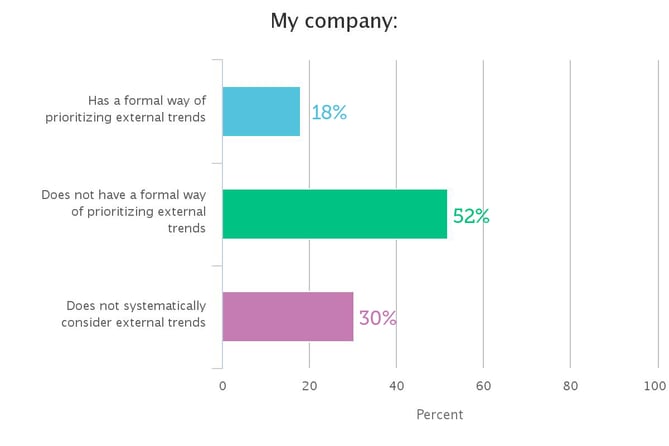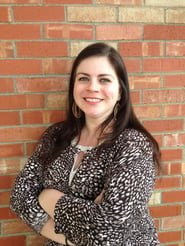Environmental assessment roadmaps were the hot topic of conversation in the recent webinar Roadmapping the Future from the Outside In with guest speakers Dr. Irene Petrick and Russ Martinelli from Trendscape Innovation Group. Attendee engagement was high, sparking captivating questions and discussions.
Webinar Polls
Two polls were presented during this webinar session. The first one asked, “How many of you are doing market-pull external views versus technology-push internal views?”
The results showed:
 Analyzing the context of the market-pull helps your company look beyond the product portfolio and see what the end-user wants, enabling you to gain insight into the factors that are influencing end-user expectations. While it's clear that looking from inside your company and out to the market in a technology-push view provides valuable information to any organization, it's less obvious — but equally as important — to evaluate your company from the outside in.
Analyzing the context of the market-pull helps your company look beyond the product portfolio and see what the end-user wants, enabling you to gain insight into the factors that are influencing end-user expectations. While it's clear that looking from inside your company and out to the market in a technology-push view provides valuable information to any organization, it's less obvious — but equally as important — to evaluate your company from the outside in.
The second poll asked, “How does your company analyze trends in the marketplace?”
Our audience responded:

Discussions while looking at your environmental/market assessments identify key trends and assumptions. Assumptions help teams question their dominant logic. If you want your company to be nimble and able to react quickly to changes and trends, it's imperative that you evaluate and assess the market in advance, giving you needed insight into the future.
Post-Webinar Questions from Audience Members
Q: How many people are usually involved in a roadmapping session?
Irene: There are different kinds of sessions, and it depends on the type of session. The first is the environmental assessment, and we have found that 15 to 20 people is really good in an environmental assessment that is cross-disciplinary. Then, we break these teams into "storytelling" groups of about four people.
By the time you get to the technology roadmap, you generally have a different, smaller set of participants. This comprises the high-level technologists, who can break down the problems and the solution sets into the technologies that go with them. At the very first roadmapping session, the assessment that we have been talking about today, probably 20 or so, but cross-functional team members are definitely essential.
Russ: When we get back to the composite roadmap (which we'll discuss in more detail in the third webinar in the series), we open it up again because this is where we need representatives from multiple disciplines and multiple functions within an organization to work together on a cross-company solution.
Q: What is the mix of people and the actual functions that you find comprise and contribute to strong environmental assessment sessions?
Irene: Generally you want to have at least one senior leader who is sponsoring the environmental assessment in the room. You will also want some technologists, marketing reps, people who are in the field, people who are doing external sales are often very good, if you have end-user experience people that is useful as well. Frequently, we bring in somebody from human resources because they are looking at the capabilities aspect that very few others in the company take into account.
Russ: Some of the best sessions have been where we brought in folks from within the company who are strong strategic thinkers and challenge everything that is going on in the room. These “havoc-causers” help the team open the conversation to new points of view that may not have been previously explored.
Q: Do you consider resource capacity during the assessment roadmap?
Irene: No, not at this level. The environmental assessment is not a place to constrain your thoughts. The time to constrain your thoughts is later on when you are actually looking at what's possible, versus what is actionable, and that we think is later in the decision-making process.
Q: What's the worry about going too far outside the box? What's the concern with that behavior?
Russ: You still have to stay within your core competencies. If you go too far outside of your core competencies, we have found that you come up with a great set of ideas of what you would like to do, but you have no ability to execute any of them. Ultimately this is all leading to an executable roadmap, and if you are trying to bring in a whole new set of capabilities, that's too far outside the box. We are really trying to redraw the box, expand the box, because we still have to be cognizant of what you are good at and build around that.
Q: Are there areas where you have experienced that strategic roadmapping is not optimal?
Irene: I've done strategic roadmapping for non-profits, I've done it for government agencies, I've done it for smaller companies, and the technique works across a wide variety of organizational types. The only place we have found where it is not optimal is if you are in an environment where your sources of competition are very predictable, where your costs are very predictable, where your product cadence is very predictable. Then, roadmapping is a resource-intensive technique that doesn't necessarily provide you additional insight.
Where roadmapping really provides insight is where there is uncertainty and an organization needs to navigate that uncertainty in a way that gives confidence that the right decisions are being made. It is much more about uncertainty level than it is about organizational type or size.
Q: If we are a team focused on just one of seven technology platforms in my company, are there risks from doing these roadmapping activities, these assessments separately?
Irene: We have worked with groups that were from different product groups within the same company. What we have found is that it makes sense to do an external assessment jointly, and then to attack the problem-finding and solution space on a product category by product category basis, but to also have some cross-fertilization from participants so that we can see potential areas of collaboration that might exist. That is very specific to how closely related the product categories or the brands are.
Q: Did you ever try to create the roadmap using a digital solution?
Russ: You will notice who our sponsor is of this webinar - Sopheon. This partnership we have with Sopheon has opened up a robust suite of electronic capability for us. We are very excited about it. Yes, we do have the capability within the Accolade solution to do all of this (and more!) digitally, for optimal cross-functional collaboration and buy-in from the entire enterprise.
Stay tuned for more key takeaways from our roadmapping series, Break Through: Identify & Solve Future Problems End-Users Care About.





